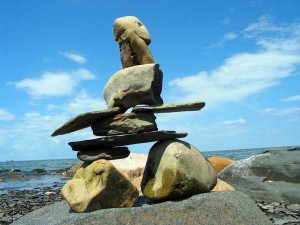Wild Sounds:
John Luther Adams’ Inuksuit
If you were to stumble upon inuksuit on the Alaskan plain, there’s a small chance you wouldn’t notice them at first. Tall rock cairns built to resemble humans and used by the Inuit for centuries to mark waypoints and hide food, they blend in with the same stones they’re created from, as though made by the Earth itself. Rock pulls inertially towards the ground, while human visage strives upwards towards the sky. It’s tough to tell where nature stops and culture begins.
 The same goes for John Luther Adams’ composition Inuksuit, to be performed on August 27th on Governor’s Island as part of the Rite of Summer music festival. A “site-determined” work inspired by the Alaskan wilderness and written to be performed anywhere outdoors, Inuksuit blurs the line between sounds made in the woods, say, and those made by them. Anywhere from 9-99 percussionists fan out across the fields, listening and responding to one another with calls, clangs, birdsongs, and other sounds that dovetail with the larger soundscape. The natural heightens the unnatural and vice versa. “Empty space,” in Adams’ words, becomes “more fully experienced place.”
The same goes for John Luther Adams’ composition Inuksuit, to be performed on August 27th on Governor’s Island as part of the Rite of Summer music festival. A “site-determined” work inspired by the Alaskan wilderness and written to be performed anywhere outdoors, Inuksuit blurs the line between sounds made in the woods, say, and those made by them. Anywhere from 9-99 percussionists fan out across the fields, listening and responding to one another with calls, clangs, birdsongs, and other sounds that dovetail with the larger soundscape. The natural heightens the unnatural and vice versa. “Empty space,” in Adams’ words, becomes “more fully experienced place.”
When you can’t tell whether you’re hearing wind or breath, you listen differently. That’s how the piece emerges. An airy drone of vocalized ahhs, shhs, and hisses gradually precipitates out of the soundscape, as though birthed by the breeze. Rubbed stones, whirled tubes, and sandblocks add similar textures. Like the inuksuit rising from the Earth, there’s no clear border to this beginning—only a realization that, in those first few moments, the beginning might have already begun. Nature had been culture all along.
As the piece progresses, breath and wind coagulate into more substantive sounds. Tibetan cymbals, temple bells, and chimes slowly enter, threatening a tempest. Bass drums pound out patterns derived from inuksuit stones. Birdsong, real and emulated, punctures the air.
Listeners contribute as well. Leaves and grass crunch underfoot as they freely amble about, further blurring musical lines. But simply standing or sitting is also permissible; there is no right way to hear the piece. If this “landscape of noise and chaos and openness,” as Adams has called Inuksuit, is “a wilderness,” then listening must remain wild, too.
It must also remain contingent. Like anything wild, Inuksuit is unknowable in its entirety. To get closer to one sound is to get farther from another, or to lose it altogether. There is no ideal place from which to hear the whole, no God’s-ear perspective; only embeddedness.
But there are guides. On the Alaskan plain, inuksuit are solitary creations, yet they aren’t meant to be appreciated as such. Instead, as directional markers, they’re relational, points from which to establish new orientations with the land. In Inuksuit, performers play a similar role. Moving outwards to isolated stations along a concentric circle, they provide musical vantage points from which listeners can reassess the ambient wilderness. Drums are listened to, but also alongside.
In the Inuit, inuksuit translates as “to act in the capacity of the human,”referring both to the stone sentinels’ human likeness and to their ability to serve as guides. But the definition also implicates humans themselves, suggesting that humanity isn’t an inalienable part of who we are but a way we choose, or choose not to, be. In Adam’s Inuksuit, to choose to be human means to choose to be mindful. “The process of listening,” Adams writes, “is a profound, a deep, mode of awareness. A way of paying attention.”
What we hear when we pay attention is potentially disconcerting.“This work,” Adams writes, “is haunted by the vision of the melting of the polar ice, the rising of the seas, and what may remain of humanity’s presence after the waters recede.”
Haunted, and yet vaguely hopeful. As the work ends, with the human wind bleeding back into the non-human one, it has proven that we have the means to listen to nature, not as an other but as our very selves.
Immerse yourself in Inuksuit on August 27th at 1pm on Governor’s Island.
